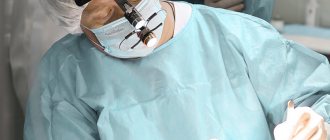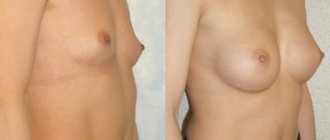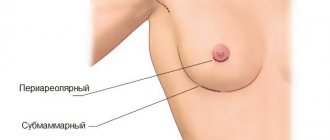Breast asymmetry
Bust asymmetry or disproportion refers to differences in breast size or shape. The disproportion may be congenital or acquired. There are different types of symmetry violation:
- by volume;
- location of the nipples and areola;
- degree of omission;
- form.
Bust disproportion is an anatomical feature, an aesthetic flaw, familiar to 80% of girls and women. It can be expressed in:
- unilateral macromastia;
- micromastia of one of the glands;
- tubular structure;
- mastoptosis of varying severity.
Plastic surgery considers 3 degrees of severity of breast disproportion (mild, moderate, severe). Depending on this, doctors offer a solution.
If you have “different breasts” - there are differences in the volume of glandular tissue, different amounts of integumentary tissue, such disharmony is corrected not by the selection of unique, extravagant in shape prostheses (although such a proposal may come), but by additional testing before endoprosthetics:
- reduction;
- mastopexy;
- and other necessary types of correction.
If you are not ready for additional surgical intervention, you should know that the disproportion can be corrected to a limited extent with the help of endoinserts. Even the best surgeon cannot promise you to create complete harmony.
If asymmetry has arisen, with your own symmetrical breasts, then the question is either about the unsatisfactory intervention of the plastic surgeon, or about your violation of the regime during the recovery period.
Reasons for asymmetry
1. Right-handedness/right-footedness and vice versa.
This is the most common reason, as everyone has it. I think there is no need to explain that there are right-handers and left-handers. And you all understand that if you, for example, are right-handed, then you make most of the movements in everyday life with your right hand. This means that by default it is more developed than the left one. That is, it is better coordinated, and the muscles on it are a little larger and stronger.
But this also applies to the legs. That is, in the same way there is left-footedness and right-footedness. Everyone has. The more active leg is also called the pushing leg, the less active leg is called the swing leg. Try a running jump forward. This is the foot you pushed off with - this is your push leg. Accordingly, your pushing leg will be larger and stronger than your swing leg.
This is the second most common reason. It concerns mainly the asymmetry of the torso, that is, the chest, back and shoulders, and not the limbs. Scoliosis is a lateral curvature of the spine. Accordingly, if there is a curvature, then even if the muscles are the same size, they will look different. I have already written about how to correct scoliosis here.
3. Specific sports and activities.
Think about sports such as discus throwing, javelin throwing, shot put, for example. There the movement occurs mainly with one hand. Accordingly, in such athletes one arm and shoulder will be much more developed. Or, for example, long jumps, where the athlete always pushes off with only one leg. The same applies to specialties and types of work where movement occurs mostly with one hand or foot.
4. Different limb lengths
This is perhaps the rarest reason. If the length is different, then the place of muscle attachment is different. Therefore, even if the total muscle mass is the same, they can look different. But, in fact, it is quite rare for the difference in limb length to be any noticeable.
Causes of breast disproportion after endoprosthetics
When correction of one deficiency leads to the emergence of another, it is very disappointing. But don't rush to blame the surgeon. The most common reasons for the development of imbalance of proportions after endoprosthetics are:
- implant rupture as a result of injury when saving money and choosing a cheap prosthesis;
- dislocation of the endoprosthesis during early physical activity and sex during early rehabilitation;
- deformation of the endoinsert and mastoptosis as a result of refusal to wear compression garments;
- sleeping on your stomach or side in the first days after surgery.
Are you sure that you followed the regime, strictly followed the instructions, and purchased a good prosthesis? Then a violation of symmetry can develop due to incorrect:
- selection of the size/shape of the prosthesis, without taking into account your anatomy;
- forming a pocket for it (by size, location);
- marking the area of operation during preliminary correction (reduction, mastopexy).
The risk that you will have one breast larger than the other after implantation of prostheses is higher if there is serious congenital disproportion.
Breast examination after breast augmentation with implants
Every woman should take care of her health and know that after 35 years it is necessary to undergo breast ultrasound and fluorography once a year. And after breast augmentation, this is extremely necessary. But most girls after plastic surgery wonder whether the examination after the operation will be reliable, and whether all areas of the breast will be visible on the machines.
It is very important to take care of yourself and think about the future, so it is necessary to undergo all examinations on time. Will implants interfere with ultrasound, mammography, CT, MRI? This is the most popular question among women who have had breast enlargement. The answer is no! The presence of breast implants will not affect the examination in any way, and will not interfere with the eventual establishment of an accurate diagnosis, provided that the examination is carried out using modern technology.
Before the examination, it is recommended to carefully select a clinic. As a rule, all modern clinics are equipped with the latest models of technology. It is recommended to first clarify whether it is possible to conduct an examination of breasts with implants, and also consult with a specialist who will select the most suitable examination method.
Types of examinations:
1. Ultrasound - ultrasound examination
. An ultrasound must be done before plastic surgery, and then repeated annually after it. Today this is the most common examination method. Ultrasound allows you to study the mammary glands before surgery, as well as exclude various kinds of complications, inflammation and adverse changes already during the rehabilitation period.
2. Mammography
. Despite the fact that mammography is the most accurate method of breast examination, it still has some difficulties. In cases where the implant was installed above the pectoral muscle, during the examination it may block some areas of the breast. If the implant is installed under the muscle, the blocked area is insignificant. The disadvantage of this method is that it will not help determine whether a breast implant is ruptured or leaking. When performing mammography, each gland is compressed first horizontally, then vertically, so the patient should warn the doctor in advance about the presence of breast implants in the mammary glands.
3. MRI - magnetic resonance imaging
. The peculiarity of the method is the use of a powerful magnetic field. MRI allows you to determine implant rupture or leakage, identify tumor foci and metastases.
4. CT - computed tomography
. This type of examination is considered the most accurate for diagnosing breast cancer. Computed tomography is classified as an X-ray method for examining the breast.
5. Fluorography
. Breast implants are visible in the fluorography image. The patient should notify the doctor in advance about their presence, but they will not interfere with the examination of the lungs, because implants easily transmit x-rays.
Thus, the presence of breast implants will not interfere with any of the listed types of examinations and obtaining accurate data on the condition of the patient’s mammary glands and lungs.
How to fix it?
What to do if the operation brings unpleasant results? Contact the surgeon who operated on you. He knows the intricacies of the operation and can assess the degree of symmetry violation. Doctors do not consider a slight difference in the shape or size of the mammary glands to be a pathology and recommend not touching it. The severe imbalance requires correction.
If your surgeon is unavailable, you can consult online with specialists by attaching before and after photos to your question. But you should know that correcting asymmetry is only operational. You can hide a defect with the help of shapewear, but only breast augmentation can remove the imbalance. If, in addition to the lack of harmony, you are worried about:
- pain;
- change in color of tissues in the bust area (redness, paleness, blueness);
- swelling began;
- the temperature has risen.
You need to urgently run to the doctor. You may have a serious complication.
Why are breasts asymmetrical?
A slight deviation in the size and shape of the left and right breasts is normal. We can talk about a problem when the difference is significant and is measured in one or even two sizes, requiring constant efforts to harmonize the figure with the help of special underwear (this is called true asymmetry).
There can be many reasons. Breast asymmetry is caused by:
- Postural disorders and scoliosis
- Unilateral breast underdevelopment
- Unilateral hypertrophied condition of the mammary gland
- Drooping of the breast (ptosis)
- Hormonal imbalances in adulthood (for example, during pregnancy) with uneven enlargement of the mammary glands
- Incorrect breastfeeding (in which the baby often suckles on one breast)
- Chest injuries
When can the result of the operation be assessed?
Many women in the first months after surgery ask how to correct asymmetry. This is unreasonable. Tissue swelling and hematomas prevent one from assessing the harmony of forms at the beginning of rehabilitation. The first results are visible after 3 months of recovery, and after six months you can evaluate the final result and draw conclusions.
Even if you have a pronounced disproportion, noticeable from the first postoperative days, repeat surgery is possible only after tissue restoration. This means that at least 6 months must pass before the surgeon’s re-intervention.
Prevention of asymmetry during lactation
To prevent one mammary gland from becoming larger than the other after breastfeeding is completed, breastfeeding must be properly organized. Prevention of asymmetry during lactation involves:
- feeding the baby not according to hours or schedule, but on demand;
- changing one breast to another no more than once every 2-3 hours;
- night feedings with both mammary glands;
- absolute refusal to pump, except in situations where you need to go away and leave food for the baby;
- exclusion of any mother substitutes.
You should not massage the mammary glands on your own to make them equal. You can’t pump in the belief that your breasts will become smaller afterwards. The removed milk will come in the same volume. Often mothers making this mistake are faced with hyperlactation.
If before pregnancy the mammary glands were symmetrical, but during lactation they became visually different, then after completion of breastfeeding, the breasts should again become the same. Severe forms of asymmetry persist in women who had similar problems before pregnancy.
If during breastfeeding one breast suddenly becomes significantly larger or takes on an irregular shape, you should consult a doctor. This sign may indicate a serious inflammatory process or tumor.
Is it possible to avoid this complication?
You can reduce the risk of developing asymmetry after mammoplasty if:
- choose a high-quality prosthesis, a good clinic, a competent doctor;
- follow all specialist recommendations during the recovery period;
- take care of the skin of the bust and carefully “wear” the implants.
With this we say goodbye to you. We are waiting for you on our page again. Read our new texts and share information with friends and acquaintances via social networks.
Problems during lactation
Size may change during breastfeeding. In this case, the reason is most likely due to improper latching or improper pumping. Incorrect attachment is a common mistake of young mothers. If the baby is in the wrong position, it does not completely clasp the nipple, and as a result, the breast does not empty completely. Cracks or stagnation of milk may occur. The breasts begin to hurt, and the woman tries to breastfeed less often - and this only aggravates the problem. To avoid such a turn of events, you need to master the correct positions for feeding.
Improper pumping leads to uneven milk production. The accumulation of milk in one of the mammary glands, in turn, leads to visible asymmetry. You need to express only when indicated; it is important to ensure that your breasts are completely emptied.
Other causes include night feedings and uneven stimulation. More milk is produced at night than during the day. Accordingly, when feeding, you need to ensure that no milk remains in the remote segments of the mammary gland. Uneven stimulation occurs if the baby is placed on one breast and only then on the other. When a baby suckles, the mother releases oxytocin, which triggers milk production. More milk appears in the breast that is stimulated. This problem is easy to solve - you need to change the mammary glands during feeding.
Answers to the most exciting questions ↑
Do all women suffer from breast asymmetry?
Paradoxically, yes. Man by nature, and the entire world around us, lacks ideal proportions. According to statistics, all those with a difference of only a few millimeters and practically unnoticeable are negligible. Most women have a range from 0.5-1 to 2 or more in size.
Can this be considered the norm?
Even a world-famous specialist cannot give a definite answer to this question. Of course, minor errors in the size or position of the mammary glands should not cause much concern. The situation is different with pronounced imbalances, the presence of which lowers aesthetic self-esteem and requires a visit to an experienced surgeon. However, in the case where the visible discrepancy is not considered a source of depression or a sign of any illness, take emergency measures to eliminate the asymmetry.
Could this be hazardous to health?
In the case of congenital asymmetry or acquired naturally (for example, as a result of lactation), there is no point in fearing for health. But if there is a sharp increase in one breast, this is at least a reason to contact a mammologist or endocrinologist to exclude the development of pathological conditions.
Is it possible to eliminate asymmetry without surgery?
With a small difference in size (no more than 1 unit) of the mammary glands, several feminine “tricks” can help. A proven method for decades, which is designed for the use of special bras with pockets for push-up inserts in the cup for the smallest breasts. Theoretically, a vacuum massage to stimulate blood circulation or a specially designed set of sports activities will be useful, which will certainly help increase the elasticity and tone of the pectoral muscle and visually increase the volume of the breast for some time. However, all surgeons are very skeptical of these methods, and based on the strict choice of selective impact on the problem organ, they claim that the best effect can only be achieved with the help of mammoplasty. And even more so, you should not oversaturate the mammary glands with various cosmetic care products, which can cause irreparable damage to an already devoid of any aesthetics bust.
Teenage changes
At the age of 9-10 years, a teenage girl begins puberty, as a result of which physiological changes occur that prepare the girl’s body for motherhood. During puberty, a girl's body turns into a girl's body.
The changes that accompany puberty begin to bother many girls, and they try to cope with them themselves.
Breast development is an inevitable aspect of puberty and can be alarming for some teenage girls. It is during this period that uneven breasts are quite common.
Some people may have smaller breasts, some may have larger ones, and in some cases the breasts grow unevenly. There are cases when, when development begins at the same time, one breast grows faster than the other. This causes one breast to become larger than the other. What to do?
| Do not be upset or sound the alarm, since breast formation is not yet completed. |











